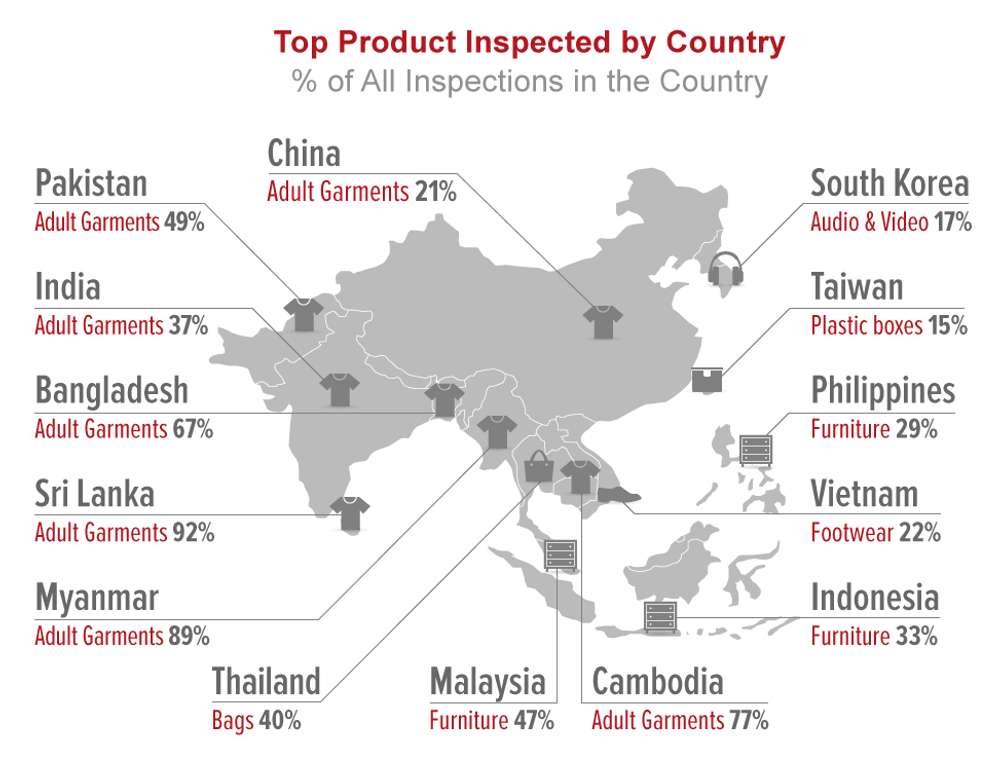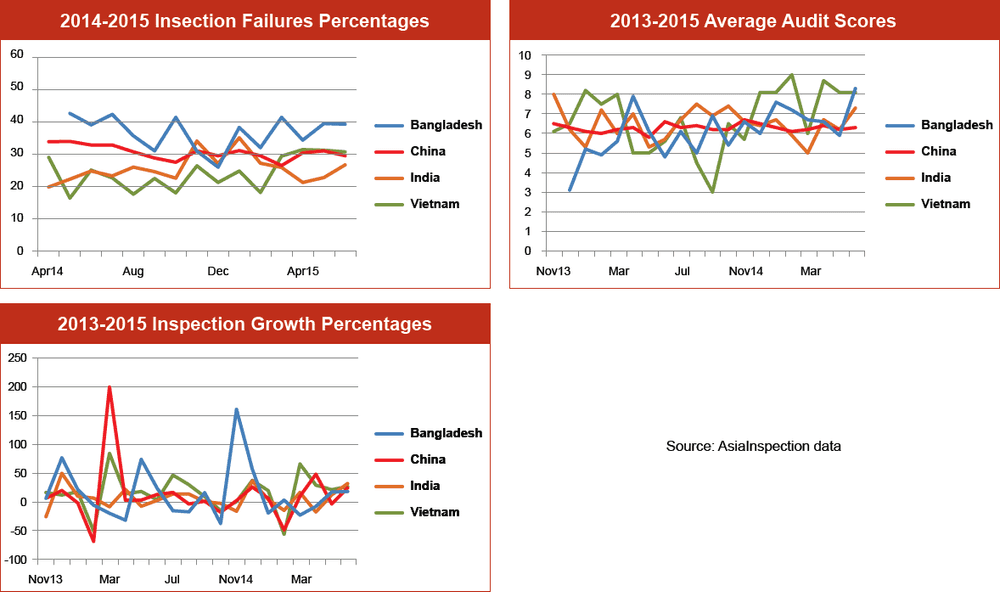مقال إخباري
بارومتر الربع الثالث من عام 2015
جنوب شرق آسيا تشهد نموًا مذهلًا وانتهاكات غذائية مستمرة
هونج كونج، 8 يوليو 2015 - أعلنت اليوم شركة QIMA، المزود العالمي الرائد لخدمات مراقبة الجودة والامتثال التي تتعاون مع العلامات التجارية وتجار التجزئة والمستوردين حول العالم لتأمين وإدارة وتحسين سلسلة التوريد الخاصة بهم، عن مقياس الربع الثالث من عام 2015، وهو ملخص ربع سنوي عن التصنيع الخارجي وصناعة خدمات مراقبة الجودة.
الصين يطغى عليها النمو المذهل في جنوب شرق آسيا


مصنع للمنسوجات في فيتنام - نمت عمليات التفتيش المطلوبة بنسبة +172% على أساس سنوي

مفتش من جهاز ضمان الجودة في مصنع في ميانمار
في حين أن اقتصاد الصين قد يكون ينمو بأبطأ وتيرة له منذ ست سنوات، إلا أن العلامات التجارية العالمية توسع بسهولة سلاسل التوريد الخاصة بها إلى وجهات أخرى منخفضة التكلفة في آسيا. وبالنظر إلى الفترة من يوليو 2014 إلى يونيو 2015 مقارنةً بالفترة من يوليو 2013 إلى يونيو 2014، تُظهر بيانات معهد قطر لبحوث الاقتصاد الإسلامي نموًا معتدلًا بنسبة 7% في عمليات فحص المنتجات التي تتم في الصين - على قدم المساواة مع نمو الناتج المحلي الإجمالي للبلاد. ومع ذلك، كان النمو مذهلًا في كل دولة أخرى في جنوب شرق آسيا تقريبًا. فقد شهدت عمليات التفتيش في كمبوديا نموًا غير مسبوق بنسبة 227% على أساس سنوي؛ وفيتنام بنسبة 172%؛ وميانمار، التي خففت في السنوات الأخيرة القيود المفروضة على الواردات وألغت ضرائب التصدير، شهدت نموًا بنسبة 133%؛ وإندونيسيا بنسبة 114%؛ وتايلاند بنسبة 102%؛ وبنجلاديش بنسبة 81%؛ وحتى باكستان الأقل شهرة شهدت زيادة بنسبة 47%.
وفي حين يبدو أن معظم النمو في جنوب شرق آسيا مدفوعًا بصادرات الملابس، إلا أن هناك استثناءات ملحوظة. وكانت أكثر المنتجات التي خضعت للتفتيش من قبل إدارة ضمان الجودة في إندونيسيا وماليزيا والفلبين هي الأثاث في إندونيسيا وماليزيا والفلبين؛ والأحذية في فيتنام، والحقائب في تايلاند، ومعدات الصوت والفيديو في كوريا الجنوبية.
وقال سيباستيان بريتو، الرئيس التنفيذي لشركة QIMA: "إن الاتجاه العام في جنوب شرق آسيا، ومعدل النمو خارج الصين لم يسبق له مثيل". "في حين أن الاتجاه التصاعدي كان موجودًا هناك في السنوات الأخيرة، إلا أن شركة QIMA تشهد طلبًا لم يسبق له مثيل. فقبل عامين، كانت الصين تمثل 91% من عمليات التفتيش، واليوم تبلغ حصتها 78%." في حين أن العلامات التجارية قد تستمر في العمل مع المصانع الشريكة الراسخة في الصين، تشير البيانات إلى أن هناك مصادر جديدة تتم في أماكن أخرى.
فيتنام - النمو مستمر، ونتائج الامتثال الأخلاقي تتصدر آسيا
تُعد فيتنام الآن رابع أكبر مُصدّر للملابس الجاهزة فيالعالم،1 وتعمل على زيادة حصتها من الصادرات مع خطط توسعية كبيرة لصناعة الملابس الجاهزة والعديد من اتفاقيات التجارة الحرة - بعضها تم توقيعه بالفعل وبعضها قيد الإعداد (بما في ذلك مفاوضات الشراكة عبر المحيط الهادئ الجارية).2، 3 لم يقتصر الأمر على زيادة عمليات التفتيش بنسبة 172% على أساس سنوي، بل كانت درجات التدقيق الأخلاقي هي الأعلى بين الأربعة الكبار في آسيا وفقًا لأرقام معهد ضمان الجودة والتحليل المالي. على مدار الاثني عشر شهرًا الماضية حصلت فيتنام على 6.7 من 10، متقدمة على الهند 6.6، والصين 6.2 وبنغلاديش 6.5.
ويمكن أن يُعزى بعض التحسن الذي شهدته فيتنام إلى التقدم الذي تم إحرازه مؤخراً في قوانين العمل في البلاد، وتحسين تمثيلالعمال،4 والجهود المبذولة لزيادة الوعي بالسلامة.5 وقد لاحظت شركة إنتل نفس الاتجاه عند نشر نتائج التدقيق الأخلاقي في منشأة التجميع الفيتنامية.6
الحواجز التجارية المخففة تغذي النمو في ميانمار
تواصل صناعة الملابس الجاهزة في ميانمار توسعها السريع، حيث تم تحديد عائدات التصدير المستهدفة للقطاع بملياري دولار أمريكي في السنة المالية 2015-2016. وفي العامين الماضيين وحدهما، تم إنشاء 100,000 مكان عمل جديد في قطاع الملابس، حيث يمثل الاستثمار الأجنبي 90 في المائة.7 وارتفع الاستثمار الأجنبي من 300 مليون دولار أمريكي في 2009-2010 إلى 5 مليارات دولار أمريكي في 2014-2015، أي بمعدل نمو سنوي قدره 75.5 في المائة.8
ومن المثير للاهتمام أن جودة المنتج في البلد تجاوزت بكثير متوسط آسيا، كما تم قياسها من خلال نتائج مستوى الجودة المقبولة لعمليات التفتيش في الموقع. فقد فشلت تفاوتات الجودة المقبولة في 22% من عمليات التفتيش، وهي أفضل من كمبوديا بنسبة 25%، والهند 28%، والصين ب>32%، وبنغلاديش 37%. ومن المحتمل أن يكون هذا انعكاسًا للاستثمارات الحديثة، وبالتالي البنية التحتية الجديدة، إلى جانب الرقابة الصارمة حيث يستخدم المشترون ضوابط صارمة أثناء انتقالهم بحذر إلى البلد.
عدم وجود لوائح سلامة الأغذية يقتل 2.2 مليون شخص سنويًا
سلامة الأغذية هو موضوع يوم الصحة العالمي لهذا العام. فوفقًا لبيانات منظمة الصحة العالمية، يموت 2.2 مليون شخص كل عام نتيجة للأمراض المنقولة بالأغذية والمياه. إن حجم وتعقيد سلاسل الإمدادات الغذائية يزيدان إلى حد كبير من خطر التلوث وانتشار الأمراض، مع ما يترتب على ذلك من عواقب صحية واقتصادية هائلة.9 وقد ظهرت أهمية لوائح سلامة الأغذية مرة أخرى في تناقض حاد مع فضيحة الأغذية الأخيرة، حيث تمت مصادرة 800 طن من اللحوم المجمدة المهربة في الصين.10
يقدم قانون سلامة الأغذية المعدل في الصين، الذي سيدخل حيز التنفيذ في أكتوبر المقبل، متطلبات أكثر صرامة للإنتاج والشحن والتخزين، بالإضافة إلى زيادة العقوبات على الانتهاكات.
مع زيادة التركيز على السلامة في صناعة الأغذية، شهدت شركة آسيا لتفتيش الأغذية زيادة بنسبة 49% في الخدمات المنجزة خلال الاثني عشر شهرًا الماضية مقارنة بالاثني عشر شهرًا السابقة، مما يجعل عمليات التفتيش على الأغذية أعلى فئة نمو في QIMA. وتظهر أحدث نتائج عمليات التفتيش تلك معدل فشل بنسبة 37% في الربع الثاني - وهو تحسن طفيف عن الربع الأول (41%).
جنوب شرق آسيا تشدد من القيود البيئية
وتبرز المخاوف البيئية بشكل متزايد مع اعتماد البلدان لوائح بيئية أكثر صرامة وتطبيقها. فقد عطلت السلطات البيئية الهندية سلاسل التوريد بإصدارها أوامر بإغلاق ما يقرب من 900 وحدة نسيج بسبب عدم تركيبها مرافق لمعالجة النفايات السائلة.11 بينما رفضت فيتنام مؤخراً اقتراحاً استثمارياً بقيمة 200 مليون دولار أمريكي، معتبرة أن مصنع النسيج والصباغة المقترح "غير سليم بيئياً".12 وفي الوقت نفسه، أصدرت الصين خطة عمل لمنع تلوث المياه ومكافحته، وحذرت السلطات من حملة وشيكة على التصريفات غير القانونية وتزوير بيانات الرصد.13، 14
مؤشرات الأداء الرئيسية لمقياس مؤشرات الأداء الرئيسية

حول QIMA - عيناك في سلسلة التوريد!
شركة QIMA (AI)، وهي شركة عالمية رائدة في مجال تقديم خدمات مراقبة الجودة والامتثال تتعاون مع العلامات التجارية وتجار التجزئة والمستوردين في جميع أنحاء العالم لتأمين وإدارة وتحسين سلسلة التوريد الخاصة بهم. ومن خلال إدارة فريدة من نوعها لمراقبة الجودة على شبكة الإنترنت، تقدم شركة QIMA خدمات فحص المنتجات وبرامج تدقيق الموردين وخدمات الفحوصات المخبرية لأكثر من 4000 عميل حول العالم. ويعدّ مقياس الربع الثالث لعام 2015 ملخصاً ربع سنوي لخدمات التصنيع ومراقبة الجودة التي تقوم بها شركة QIMA كل عام(عمليات فحص المنتجات، وبرامج تدقيق الموردين، والفحوصات المخبرية).
الاتصال بالصحافة
مايكل ميسارش
هاتف: (+86) 755 2223 2223 9888+
البريد الإلكتروني: press@qima.com
الحواشي
1. فيتنام نت. فيتنام تصبح رابع أكبر مصدر للملابس الجاهزة في العالم. 24 يونيو 2015.
2. مركز منظمة التجارة العالمية VCCI TRUNGTAMWTO. الرابطة الأوروبية للتجارة الحرة وفيتنام تواصلان محادثات التجارة الحرة. مايو 30, 2015
3. فوربس. كيف يمكن للتعريفات الجمركية المنخفضة بموجب اتفاقية الشراكة عبر المحيط الهادئ أن ترسل المزيد من وظائف نايكي إلى فيتنام - وتضر بالشركة. 9 مايو 2015. http://www.forbes.com/sites/panosmourdoukoutas/2015/05/09/how-lower-tariffs-under-tpp-could-send-more-nike-jobs-to-vietnam-and-harm-the-company/
4. مجلة بوليتيكو. الشراكة عبر المحيط الهادئ ستساعد العمال في فيتنام على متابعة حقوقهم. 8 يونيو 2015.
5. أخبار فيتنام العاجلة. سباق الجري الترفيهي يهدف إلى رفع مستوى الوعي حول الصحة والسلامة في مصانع الملابس في فيتنام مايو 14, 2015
6. إنتل. إنتل فيتنام: "واحدة من الأفضل". 12 يونيو 2015. https://blogs.intel.com/csr/2015/06/intel-vietnam-one-of-the-best/
7. شينخوا نيوز. ميانمار تتوسع في صناعة المنسوجات والملابس الجاهزة لتحقيق نمو اقتصادي أكبر. 7 أبريل 2015.
8. REUTERS. ميانمار ترى أن الاستثمارات الأجنبية ستتجاوز 5 مليارات دولار في 2014-2015. 16 سبتمبر 2014.
9. منظمة الصحة العالمية، أوروبا. السلسلة الغذائية المعقدة تزيد من مخاطر سلامة الأغذية. 31 مارس 2015.
10. سي إن إن. أحدث فضائح الصين الغذائية التي تحرق المعدة: اللحوم المجمدة من السبعينيات. يونيو 25, 2015 http://edition.cnn.com/2015/06/24/asia/china-smuggled-meat/
11. Ecotextile. أمر بإغلاق 893 وحدة نسيج ملوثة في الهند. 13 مايو 2015. http://www.ecotextile.com/2015051321470/dyes-chemicals-news/893-polluting-textile-units-order-to-close-in-india.html
12. Asian Sourcing Sourcing Link. فيتنام ترفض استثمارات أجنبية في مجال المنسوجات بملايين الدولارات. مايو 11, 2015
13. MarketWatch. داخل خطة الصين الكبرى لمكافحة تلوث المياه. 4 مايو 2015. http://www.marketwatch.com/story/inside-chinas-grand-plan-for-water-pollution-2015-05-04
14. Sourcing Journal. الصين تستهدف مصانع النسيج المستهدفة بخطة جديدة لحماية المياه. مايو 15, 2015 https://www.sourcingjournalonline.com/chinese-textile-mills-targeted-new-water-protection-plan-lm/